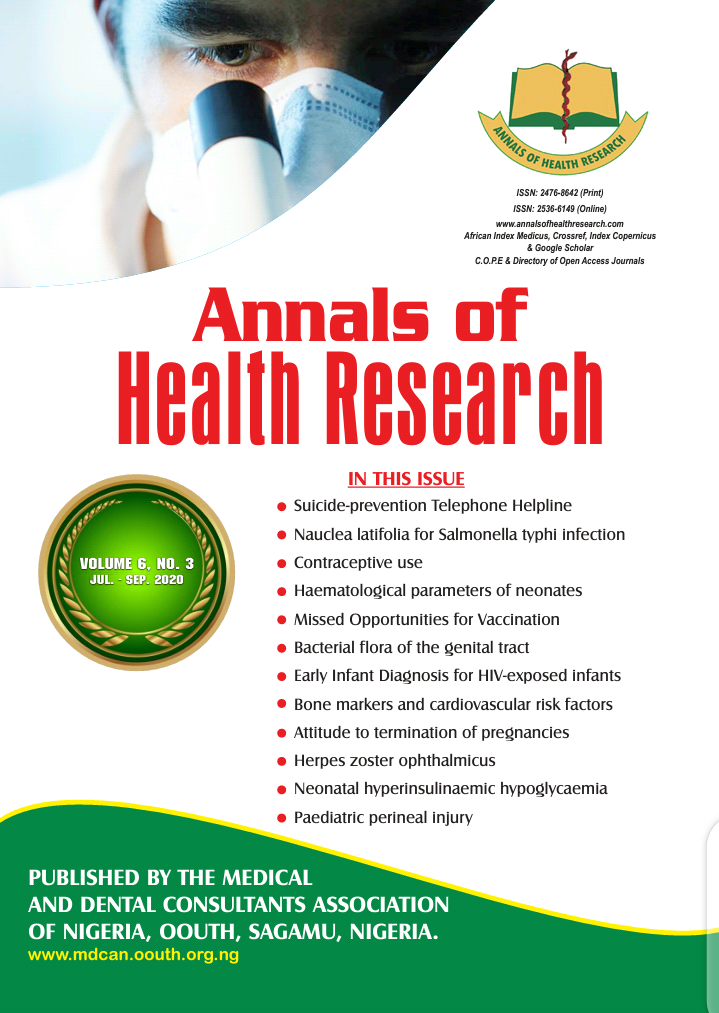Diazoxide use for neonatal hyperinsulinaemic hypoglycaemia in a low-resource setting: A Case Report
DOI:
https://doi.org/10.30442/ahr.0603-11-97Keywords:
Critical sample, Diazoxide, Hyperinsulinaemic hypoglycaemia, Maternal diabetes, NewbornAbstract
The management of neonatal hyperinsulinaemic hypoglycaemia remains a major challenge in hospitalized newborns globally. Diazoxide is one of the recommended therapeutic options.
We report a late preterm, male infant of a diabetic mother who suffered severe perinatal asphyxia and had persistent hypoglycaemia requiring progressively increasing intravenous glucose concentrations to as high as 12.5 mg/kg/minute along with intravenous hydrocortisone administration. A critical sample revealed inappropriately high serum insulin, inappropriately low serum cortisol and growth hormone responses. Urinalysis was negative for ketones. With the persistence of hypoglycaemia, oral diazoxide at 5 mg/kg/day with oral hydrochlorothiazide was administered. The infant was diazoxide-responsive with complete resolution of hypoglycaemia. Diazoxide therapy was discontinued after 14 days and he was discharged after one month of admission. This report emphasizes the importance of diazoxide in the management of neonatal transient hyperinsulinaemic hypoglycaemia. The availability and cost of diazoxide, as well as the endocrine and metabolic tests, are major concerns in resource-poor settings.
References
Ochoga M, Aondoaseer M, Abah R, Ogbu O, Ejeliogu E, Tolough G. Prevalence of Hypoglycaemia in Newborn at Benue State University Teaching Hospital, Makurdi, Benue State, Nigeria. Open J Pediatr 2018; 8: 189-198.
Dedeke IOF, Okeniyi JAO, Owa JA, Oyedeji GA. Point-of-admission neonatal hypoglycaemia in a Nigerian tertiary hospital: incidence, risk factors and outcome. Niger J Paediatr 2011; 38: 90-94.
Adamkin DH, Polin RA. Imperfect advice: neonatal hypoglycaemia. J Pediatr 2016; 176: 195–196.
Committee on Fetus and Newborn, Adamkin DH. Postnatal glucose homeostasis in late preterm and term infants. Pediatrics 2011; 127: 575 579.
Thornton PS, Stanley CA, De Leon DD, Harris D, Haymond MW, Hussain K, et al. Recommendations from the Pediatric Endocrine Society for evaluation and management of persistent hypoglycemia in neonates, infants, and children. J Pediatr 2015; 167: 238‑245.
Kapoor RR, Flanagan SE, James C, Shield J, Ellard S, Hussain K. Hyperinsulinaemic hypoglycaemia. Arch Dis Child 2009; 94: 450-457.
Ferrara C, Patel P, Becker S, Stanley CA, Kelly A. Biomarkers of insulin for the diagnosis of hyperinsulinemic hypoglycemia in infants and children. J Pediatr 2016; 168: 212‑219.
Shrenik V, Suresh C, Victor SR, Khalid H. Hyperinsulinemic hypoglycemia in infancy: Current Concepts in Diagnosis and Management. Indian Pediatr 2015; 52: 1051-1059.
Rozance PJ, Wolfsdorf JI. Hypoglycemia in the newborn. Pediatr Clin N Am 2019; 66: 333–342.
Hussain K. Diagnosis and Management of Hyperinsulinaemic Hypoglycaemia of Infancy. Horm Res 2008; 69: 2–13.
Arya VB, Flanagan SE, Kumaran A, Shield JP, Ellard S, Hussain K, et al. Clinical and molecular characterisation of hyperinsulinaemic hypoglycaemia in infants born small-for-gestational-age. Arch Dis Child Fetal Neonatal Ed 2013; 98: F356–F358.
Touati G, Poggi-Travert F, Rahier J, Brunelle F, Nihoul-Fekete C, Czernichow P, et al. Long-term treatment of persistent hyperinsulinaemic hypoglycaemia of infancy with diazoxide: a retrospective review of 77 cases and analysis of efficacy-predicting criteria. Eur J Pediatr 1998; 157: 628–633.
Yoshida K, Kawai M, Marumo C, Kanazawa H, Matsukura T, Kusuda S, et al. High prevalence of severe circulatory complications with diazoxide in premature infants. Neonatology 2014; 105: 166-171.
Alexander, S, Anazodo, A and Hussain, K. Interactions of diazoxide with frusemide, spironolactone, and acetylsalicylic acid in a patient with hyperinsulinism of infancy and Fallot tetralogy. Eur J Pediatr 2003; 162: 806-807.
Rozance PJ, Hay WW. Hypoglycemia in newborn infants: features associated with adverse outcomes. Biol Neonate 2006; 90: 74–86.
Clark W, O'Donovan D. Transient hyperinsulinism in an asphyxiated newborn infant with hypoglycemia. Am J Perinatol 2001; 18: 175–178.
The selection and use of essential medicines: report of the WHO Expert Committee on Selection and Use of Essential Medicines, 2019 (including the 21st WHO Model List of Essential Medicines and the 7th WHO Model List of Essential Medicines for Children). Geneva: World Health Organization; 2019 (WHO Technical Report Series, No. 1021). Licence: CC BY-NC-SA 3.0 IGO. Available at https://apps.who.int/iris/bitstream/handle/10665/330668/9789241210300-eng.pdf?ua=1. Accessed on March 25th 2020.
UN Committee on Economic, Social and Cultural Rights. General Comment No. 14, U.N. Doc. E/C.12/2000/4. 2000. Available at https://www.refworld.org/pdfid/4538838d0.pdf. Accessed on March 25th 2020.
Hu S, Xu Z, Yan J, Liu M, Sun B, Li W, et al. The treatment effect of diazoxide on 44 patients with congenital hyperinsulinism. J Pediatr Endocrinol Metab 2012; 25: 1119-1122.
Papiya K, Khalid H, Sarah EF, Sudip C, Dhananjoy B. Nifedipine in congenital hyperinsulinism-a case report. J Clint Res Paediatr Endocrinol 2015; 7: 151-154.
Downloads
Published
Issue
Section
License
The articles and other materials published in the Annals of Health Research are protected by the Nigerian Copyright laws. The journal owns the copyright over every article, scientific and intellectual materials published in it. However, the journal grants all authors, users and researchers access to the materials published in the journal with the permission to copy, use and distribute the materials contained therein only for academic, scientific and non-commercial purposes.


